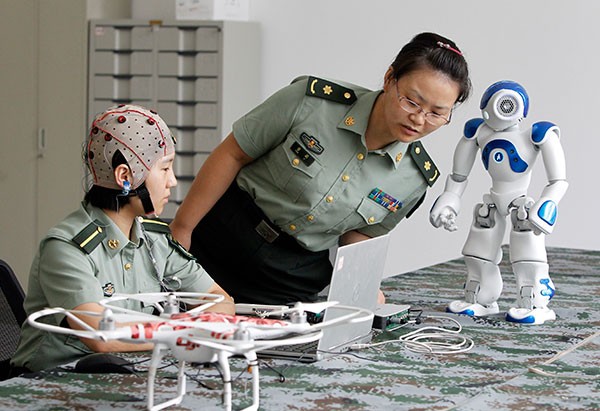The U.S. movie "Iron Man" features business tycoon Tony Stark, who invented a robotic suit that gave him inexhaustible power to fight villains.
But when that suit is brought to the real world, it would be too heavy and unwieldy that even "Iron Man 3's" lead actor Don Cheadle remarked that it was "not really cool at all" to play as the superhero in the suit.
Scientists from China are now developing a flexible and manageable exoskeleton that moves as lively, as its limbs are mind-controlled.
Chinese scientists from the Institute of Advanced Manufacturing Technology in Changzhou, Jiangsu Province, recently finished an exoskeleton that enables ordinary people to climb mountains while carrying 30 kilograms of gear or punch through a wall with no sweat.
Unlike the hyper red color and cool looks of the Iron Man suit, the exoskeleton resembles an iron skeleton with a multitude of sensors and electric wires. It senses the wearer's neuromuscular signals and reacts with the corresponding action.
"Artificial intelligence will bring us into the second machine age--an age featuring exponential growth, digitization and combined innovation," Tan Tieniu, deputy secretary-general of the Chinese Academy of Sciences, said at a Brain-Inspired Intelligence Forum in June.
One application of the exoskeleton would be in combat soldiers. This would give them enough strength and boost their fighting capacity. Another use would be superhuman abilities ideal in emergency situations, such as fire fighting and earthquake rescues.
Exoskeletons can also be used in the medical industry, making it possible for disabled people to walk or make movements, such as kicking a ball. An example would be the 29-year-old paraplegic Juliano Pinto, who used a mind-controlled exoskeleton to kick a soccer ball to commence the games at the 2014 FIFA World Cup in Brazil.
When a person desires to move using the mind-controlled exoskeleton, the electrode cap senses the change in brain waves of the person and responds with the movement almost real-time. Meanwhile, the neuromuscular sensors can only detect the body's movement when the person starts to move, so they respond slower.
Mind-controlled machines have been a research topic in the neuroscience field since the 1970s at the University of California, Los Angeles.
With increasing triumphs in usage of mind-controlled machines, governments are investing more money into this technology.
The BRAIN program, or Brain Research through Advancing Innovative Neurotechnologies, was announced by U.S. President Barack Obama in April 2013. The president gave $100 million to study and map the human brain.
The European Union's Horizon 2020, the biggest EU research and innovation program, also focuses on brain research.
According to Yang Zhi, a cognitive neuroscience researcher at the Chinese Academy of Science's Institute of Psychology, in spite of the fact that people can use their minds to control external devices, machines are still incapable of understanding human thoughts.
The same technology has also been used to examine the brain activity of patients in a crippled state to get their answers to questions like, "Can you feel any pain?"
Relating human thought to corresponding brain activity is paramount to diversifying the usage and application of mind control, Yang said.



























